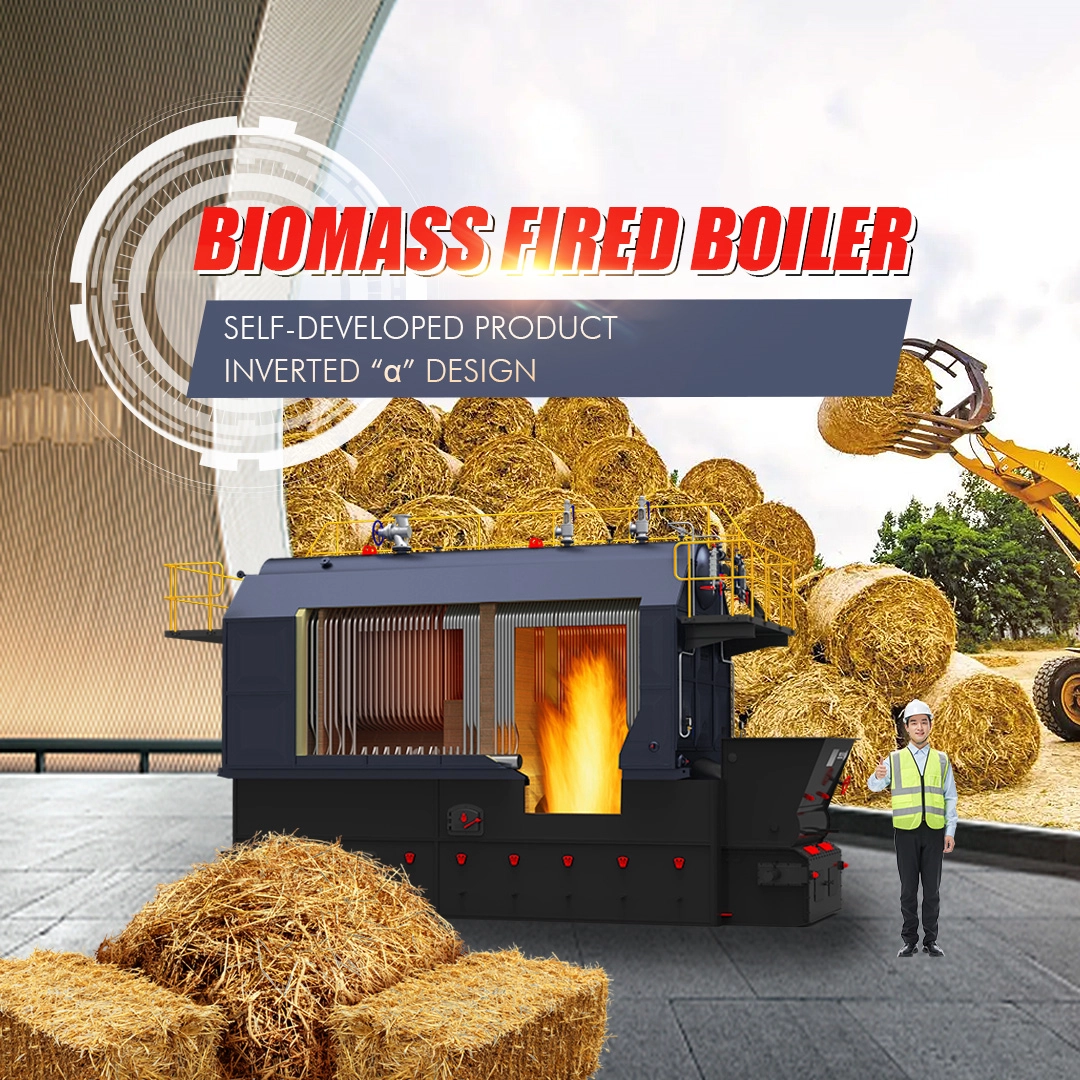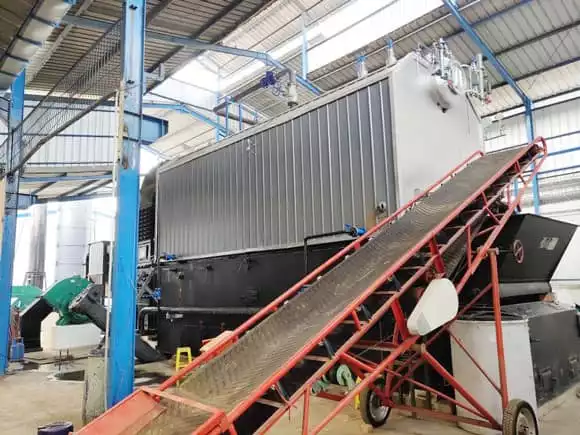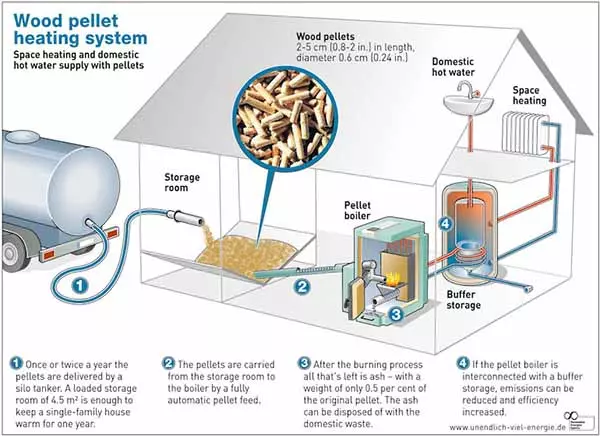
Biomass fuel is becoming an increasingly popular source of renewable energy because it is environmentally friendly and has a low carbon footprint. Biomass fuel feeding systems are used to transfer biomass fuels from the storage silos to the boilers for combustion. In questo blog, we will be discussing the main components of a biomass fuel feeding system and how they work.
UN biomass boiler system, in technical terms, is a heating system that utilizes biomass as a renewable energy source to generate heat. Biomass refers to organic materials, such as wood pellets, rifiuti agricoli, or dedicated energy crops, which are used as fuel in the boiler system.
FANGKUAI, as a global leader in boiler technology, has made significant strides in developing innovative biomass boiler systems that are highly efficient and environmentally friendly. Our biomass boilers are equipped with advanced combustion technology to ensure optimal conversion of biomass into heat energy, minimizing harmful emissions and maximizing energy efficiency.
 Ricevi oggi stesso preventivi GRATUITI per caldaie locali
Ricevi oggi stesso preventivi GRATUITI per caldaie locali Confronta i migliori prezzi
Confronta i migliori prezzi Risparmia oggi stesso sulla tua nuova caldaia!
Risparmia oggi stesso sulla tua nuova caldaia!Companies use fuel storage silos to store bulk biomass fuel supplies. These silos come in various sizes, constructed from concrete, steel, or aluminum, tailored to specific requirements. Depending on the application, the silos can be situated either indoors or outdoors.
Fuel feed augers play a crucial role in transporting biomass fuel from storage silos to the boiler grate for combustion. Augers utilize a screw mechanism that propels the fuel through a tube or channel towards the boiler.
The fuel distributor ensures an even distribution of fuel across the boiler grate. This can involve a rotating arm moving across the grate for uniform fuel distribution, or a stationary distribution system can be employed.
Energy production begins on the fuel grate, where biomass fuel undergoes combustion. The design of the grate varies based on the specific fuel type being burned.
The biomass fuel feeding system is effectively operated and monitored through a control system. This system can incorporate automatic controls that regulate the fuel flow rate in response to the boiler’s load.

Biomass fuel feeding systems offer several advantages over traditional fossil fuel systems:
 Ricevi oggi stesso preventivi GRATUITI per caldaie locali
Ricevi oggi stesso preventivi GRATUITI per caldaie locali Confronta i migliori prezzi
Confronta i migliori prezzi Risparmia oggi stesso sulla tua nuova caldaia!
Risparmia oggi stesso sulla tua nuova caldaia!To provide fuel for a biomass boiler, several methods can be utilized. One common approach is through the use of a fuel storage and handling system. This system typically includes components such as fuel storage silos or containers, conveyors or augers for transporting the fuel, and equipment for unloading and feeding the fuel into the boiler.
The specific design and configuration of the fuel storage and handling system may vary depending on the type and characteristics of the biomass fuel being used. For instance, wood pellets may require a different handling system compared to agricultural waste or dedicated energy crops.
Grate boilers find widespread application in biomass combustion and exhibit the capacity to accommodate an array of fuel types, encompassing wood fuels, carbone, waste fuels, peat, and even straw. Within these boilers, a grate mechanism takes center stage, facilitating the fuel’s introduction onto the grate. This movement can be governed through adjustable gates or the manipulation of the fuel movement speed positioned below the gate. As the fuel traverses the grate, combustion occurs, engendering heat that powers the boiler.

The biomass boiler process consists of a series of distinct stages. To begin with, biomass fuel, encompassing materials such as wood pellets or agricultural waste, is initially stored in a dedicated fuel storage silo or container. Following this, the fuel is efficiently conveyed to the boiler using conveyors or augers, streamlining the process and ensuring a consistent fuel supply.
Inside the boiler, the biomass fuel undergoes combustion, thereby releasing heat energy. This heat is then harnessed to convert water into steam through a steam-water system. The process begins with water heating, followed by evaporation, and ultimately superheating, all powered by the energy derived from combustion. Essential components encompass tubes, pipes, valvole, and diverse fittings.
The steam generated serves a multitude of purposes, including building heating, water heating, or even electricity generation by means of steam turbines. Furthermore, specific biomass boilers can employ thermochemical techniques to manufacture liquid or gaseous fuels such as renewable diesel, methane, or even renewable jet fuel.
 Ricevi oggi stesso preventivi GRATUITI per caldaie locali
Ricevi oggi stesso preventivi GRATUITI per caldaie locali Confronta i migliori prezzi
Confronta i migliori prezzi Risparmia oggi stesso sulla tua nuova caldaia!
Risparmia oggi stesso sulla tua nuova caldaia!Ora, let’s embark on the journey of designing a biomass fuel feeding system that seamlessly integrates with your boiler setup. The cornerstone of this process is determining your fuel storage requirements and capacity. Accurate calculations prevent interruptions in fuel supply and guarantee your system’s reliability.
Fuel handling equipment plays a pivotal role in this system. From screw conveyors that ensure a consistent feed rate to hoppers equipped with agitators that prevent bridging, your choice impacts the overall efficiency. Tailor your selection to suit your needs, whether it’s precise delivery or preventing fuel clogs.
At the core of the system rests the fuel delivery mechanism, a pivotal element in sustaining continuous boiler operation. Consider it akin to a symphony – the delivery system’s precision orchestrates each note in perfect harmony, ensuring a seamless performance.
With the design in place, it’s time to bring your biomass fuel feeding system to life. Proper site preparation is paramount, shielding your equipment from the elements and ensuring safety for both operators and equipment. Mother Nature can be unpredictable, but a well-prepared site can weather any storm.
The installation process involves configuring fuel storage and handling equipment. This step requires attention to detail – every connection, every setting matters. The components must work in tandem, like pieces of a puzzle coming together to form the big picture.
Connecting the fuel delivery system to the boiler is the moment of truth. Compatibility is key here, ensuring that the feed system seamlessly integrates with the boiler. As you make these connections, envision the energy flow – a continuous dance between the fuel and the boiler, choreographed for optimum efficiency.
 Ricevi oggi stesso preventivi GRATUITI per caldaie locali
Ricevi oggi stesso preventivi GRATUITI per caldaie locali Confronta i migliori prezzi
Confronta i migliori prezzi Risparmia oggi stesso sulla tua nuova caldaia!
Risparmia oggi stesso sulla tua nuova caldaia!Biomass fuel feeding systems are an important part of any biomass boiler system. They allow for the efficient and reliable transfer of biomass fuels from storage to the boiler for combustion. The advantages of biomass fuel systems make them an attractive alternative to traditional fossil fuel systems. With the increasing demand for renewable energy sources, biomass fuel systems will continue to grow in popularity and become a more common sight in industrial, commerciale, and residential settings.
PREVENTIVI CALDAIE GRATUITI
Nessun ritardo, Ottenere 3 citazioni oggi Confronta per i migliori prezzi Sicuro e affidabileRECENSIONI
COSA C'È IN QUESTO ARTICOLO?
vVisualizza le recensioni dei nostri clienti
"Ho acquistato una caldaia a vapore Fangkuai per la mia fabbrica e funziona perfettamente da mesi ormai. La qualità dei materiali e la costruzione della caldaia sono impressionanti. È anche molto efficiente dal punto di vista energetico, che ci ha aiutato a risparmiare sulle nostre bollette energetiche. Consiglio vivamente i prodotti Fangkuai a chiunque necessiti di soluzioni di riscaldamento affidabili ed efficienti."
John
Stati Uniti d'America"Utilizziamo da anni la caldaia ad olio diatermico Fangkuai per il nostro impianto chimico e non ci ha mai deluso. La caldaia è molto resistente e può resistere a condizioni difficili. È anche molto facile da usare e mantenere, che ci ha aiutato a risparmiare tempo e denaro per la manutenzione. Le caldaie ad olio diatermico Fangkuai sono di prim'ordine e le consiglio vivamente a chiunque necessiti di soluzioni di riscaldamento affidabili."
Chang
Cina"L'attrezzatura ausiliaria di Fangkuai ha reso il mio sistema di caldaie ancora migliore. La qualità dell'attrezzatura è eccezionale ei prezzi sono molto ragionevoli. L'apparecchiatura ha contribuito a migliorare l'efficienza e le prestazioni del mio sistema di caldaie, che ha portato a notevoli risparmi sui costi. Consiglio vivamente l'attrezzatura ausiliaria di Fangkuai a chiunque necessiti di accessori per caldaie di alta qualità."
Maryk
UK"Ho acquistato una caldaia a vapore Fangkuai per la mia fabbrica e funziona perfettamente da mesi ormai. La qualità dei materiali e la costruzione della caldaia sono impressionanti. È anche molto efficiente dal punto di vista energetico, che ci ha aiutato a risparmiare sulle nostre bollette energetiche. Consiglio vivamente i prodotti Fangkuai a chiunque necessiti di soluzioni di riscaldamento affidabili ed efficienti."
John
Stati Uniti d'America"Sono rimasto molto colpito dalla qualità della caldaia per l'acqua calda di Fangkuai. È costruito per durare e ha superato le mie aspettative. Anche il processo di installazione è stato molto fluido e il servizio clienti è stato eccellente. La caldaia per l'acqua calda è molto facile da usare e manutenere, e l'efficienza energetica è notevole. Consiglio vivamente le caldaie ad acqua calda di Fangkuai."
Jack
Australia"La caldaia per l'acqua calda di Fangkuai è fantastica. Si riscalda in modo rapido ed efficiente, e l'acqua rimane calda per molto tempo. Non abbiamo mai avuto problemi e ha apportato un miglioramento significativo alle nostre operazioni quotidiane. Anche il processo di installazione è stato molto fluido e il servizio clienti è stato eccellente. Consiglio vivamente le caldaie ad acqua calda di Fangkuai."
Sara
Canada"Utilizziamo da anni la caldaia ad olio diatermico Fangkuai per il nostro impianto chimico e non ci ha mai deluso. La caldaia è molto resistente e può resistere a condizioni difficili. È anche molto facile da usare e mantenere, che ci ha aiutato a risparmiare tempo e denaro per la manutenzione. Le caldaie ad olio diatermico Fangkuai sono di prim'ordine e le consiglio vivamente a chiunque necessiti di soluzioni di riscaldamento affidabili."
Chang
Cina"Ho acquistato una caldaia a vapore Fangkuai per la mia fabbrica e funziona perfettamente da mesi ormai. La qualità dei materiali e la costruzione della caldaia sono impressionanti. È anche molto efficiente dal punto di vista energetico, che ci ha aiutato a risparmiare sulle nostre bollette energetiche. Consiglio vivamente i prodotti Fangkuai a chiunque necessiti di soluzioni di riscaldamento affidabili ed efficienti."
John
Stati Uniti d'America"I generatori di vapore di Fangkuai sono eccellenti. Sono molto facili da usare e richiedono una manutenzione minima. Anche il servizio clienti di Fangkuai è eccezionale. Sono molto reattivi e sempre disposti ad aiutare. Notevole anche l'efficienza energetica dei generatori di vapore, che mi ha aiutato a risparmiare sulle mie bollette energetiche. Consiglio vivamente i generatori di vapore di Fangkuai."
Maria
Spagna